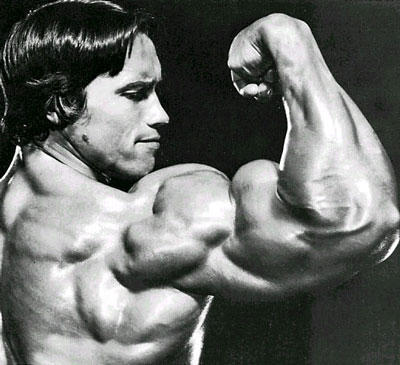From the most stable to the least stable, you have:
- Machine
- Barbell
- Cable
- Dumbbell
Machines are the most stable. They work a major muscle and neglect the the small stabilizer muscles. On the other end of the spectrum, you have dumbbells which require a fair amount of stabilizer muscles. One is not better than the other. It all depends on what your goals are. Below, we have the advice of the most successful bodybuilders saying that both stable and unstable equipment are necessary for growth.
Dexter Jackson
2008 Mr. Olympia on choosing the right equipment

What I'm a firm believer in is
barbells build mass. OK. Dumbells -
you can build a little mass, but it's
mostly for shaping. Say for example,
you're doing 500 lb bench press.
You're not going to get 250 lb
dumbbells. You can't do that. The more
weight you do, the bigger you're
become because it's heavier.
Therefore, barbells, to me is a mass
builder of every exercise.
With machines, you can even do more weight than a barbell because no energy has to be expended to stabilize the weight. So by the transitive property, machines are great for mass building.
Dorian Yates
6 time Mr. Olympia on machines vs. free weights (4:15)

There's a debate. What's better?
Machines or free weights? Neither.
They're both tools you can use. As
long as you're working a muscle to
failure, it doesn't matter if it's a
machine or free weight.
There's advantages and disadvantages.
The advantage with free weights, of
course, is we're all built
differently. We're all different
heights. We all have different lengths
of limbs. Different attachments and
everything. Whereas a machine is just
built in one way. If you lift a free
weight and I lift a free weight, we'll
take a slightly different pathway
because or bodies are built
differently. So that's the advantage
of a free weight . It works with the
individual's body.
With machines, you're locked into a
groove. The advantage of a machine is
you can isolate without too much
outside involvement. Especially if you
have injuries, they're very useful.
You have more control if you want to
do extra negatives and so on. If
you're doing a free weight bench press
it's very awkward to do extra
negatives at the end. It's just not
practical. It's not really safe. With
a machine, you can get your training
partner to lift to the top and control
it. It's safe.
I use both in my training. I use free
weights and I use machines. The main
thing is the effort you're putting in,
not the tools you use.
To summarize, Dorian says machines are better if need to work around an injury or need to do advanced techniques like forced negatives. On the other hand, free weights feel more natural and work for any body type. From personal experience, I feel the same about Dorian on the natural feel of free weights. When using bench press machines, I often find my wrists contorted into awkward positions at the peak of the movement.
Arnold Scwarzenegger
7 time Mr. Olympia in his Encyclopedia of Bodybuilding

For a beginning bodybuilder, the
majority of training should be done
with free weights. We live in a
technological age, and the exercise
machines being designed and
manufactured today are better than
ever. But your muscles were designed
by evolution to overcome the pull of
gravity rather than to work against
machine resistance, so the biggest
gains you will make in building size
and strength will come from pumping
iron - using a barbell and dumbbells -
rather than exercising on machines.
...
Additionally, a report in the Journal
of Strength and Conditioning Research
indicates that testosterone production
is increased when you do
large-muscle-group, free-weight
exercises in which you use and
coordinate a number of major muscle
groups at the same time, like the
Squat, Deadlift, and exercises you see
performed less often today like the
Power Clean. Testosterone production
is not similarly increased by
isolation free-weight exercises - or
training on machines.
...
Again, let me emphasize that I am not
against machines. ... We've been
through air- and water-resistance
machines, and are now back to more
basic design, bt a hundred times
better than ever before.
...
I use a lot of machines in my own
workouts. It's obviously impossible to
get full thigh development, for
example, without a Leg Extension or
Leg Curl machine or to fully isolate
the inner chest without using a pec
deck, or cables. And it is possible to
shock the body into accelerated growth
if you occasionally use a machine or
circuit of machines you are not used
to in place of your normal free-weight
exercise for that body part. But I
believe a good bodybuilding program
should include no more than 30 to 40
percent training (at most!) with
machines.
To summarize, Arnold believes that machines add variety to a workout and variety is the key to growth. He recommends using more free weights than machines because our bodies have evolved to grow better with free weights. He also points out many of the things Dorian Yates advocates, but I left them out of my quoting.


